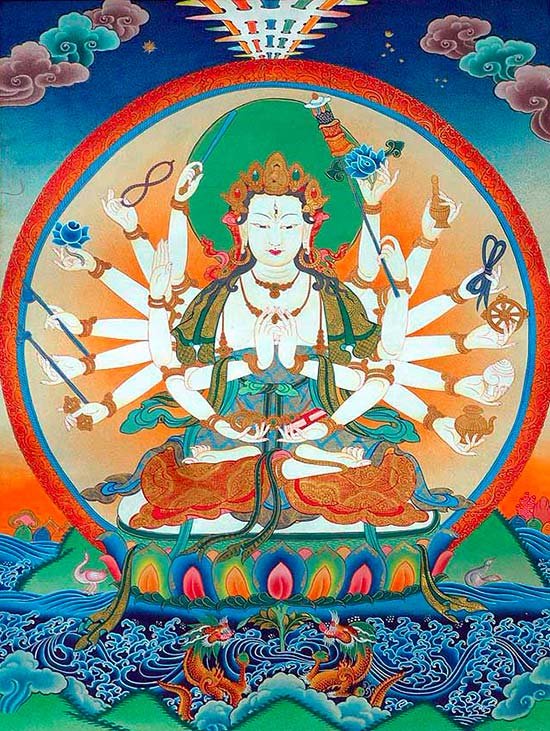Maha Prajnaparamita Sastra
by Gelongma Karma Migme Chödrön | 2001 | 941,039 words
This page describes “preliminary note” as written by Nagarjuna in his Maha-prajnaparamita-sastra (lit. “the treatise on the great virtue of wisdom”) in the 2nd century. This book, written in five volumes, represents an encyclopedia on Buddhism as well as a commentary on the Pancavimsatisahasrika Prajnaparamita.
Understanding dharmatā: Preliminary note
The problem of causality was the object of the preceding section: the author came to the conclusion that if this question is asked from the point of view of apparent truth (saṃvṛtisatya), it is to be rejected, or, rather, to be dismissed from the point of view of absolute truth (paramārthasatya).
Here he passes on to a connected question which is that of the sarvadharmāṇāṃ dharmatā, ‘the dharma-nature of dharmas’, an expression which Kumārajīva usually translates as tchou-fa-che-siang: ‘the true nature (bhūtalakṣaṇa) of dharmas ‘ (see vol. III, Introduction, p. xliiF).
Dharmatā often appears in a list of synonyms which has increased over time. Contrary to the Tibetans, the Chinese lack consistency in their way of rendering these terms. The equivalents proposed by Kumārajīva are not repeated by Hiuan-tsang, and, on the pain of falling into unfortunate confusion, it is important to distinguish them carefully:
(Sanskrit) dharmatā,
(Tibetan) chos ñid,
(Kumārajīva) che siang,
(Hiuan-tsang) fa eul, fa sing
(Sanskrit) tathatā (‘manner of being’),
(Tibetan) de bśin ñid,
(Kumārajīva) jiu,
(Hiuan-Tsang) tchen jou,
(Sanskrit) dharmadhātu (‘fundamental element’),
(Tibetan) chos kyi dbyiṅs,
(Kumārajīva) fa sing,
(Hiuan-Tsang) fa kiai,
(Sanskrit) bhūtakoṭi (‘limit of truth’),
(Tibetan) yag dag paḥi mthaḥ,
(Kumārajīva) che tsi,
(Hiuan-Tsang) che tsi.
The passage of the Pañcaviṃśati commented on here by the Traité is limited to these four terms, but other lists, more complete, have already been proposed by the earliest canonical texts:
Saṃyutta, II, p. 25, l. 19–20: dhātu, dhammaṭṭhitatā, dhammaniyāmatā, idappaccayatā.
Saṃyutta, II, p. 26, l. 5–6: tathatā, avitathatā, anaññathatā, idappaccayatā.
Nidānasaṃyukta, p. 148: dharmatā, dharmasthitaye dhātuḥ.
Ibid., p. 149: dharmatā, dharmasthitatā, dharmaniyāmatā, dharmayathatathā, avitathatā, ananyathā, bhūta, satyatā, tattvaā, thatāthatā, aviparītatā, aviparyastatā, idaṃpratyatā, pratītyasamutpādānulomatā.
Ibid., p. 164: dharmatā, dharmasthitaye dhātuḥ.
Anguttara, I, p. 286, l. 7–8: dhātu, dhammaṭṭhitatā, dhammaniyāmatā.
Sanskrit Mahāparinirvāṇa, p. 168: dharmatā, dharmasthitaye dhātuḥ.
Śalistamba, ed. Sastri, p. 4, l. 5–7: dharmatā, dharmasthititā, dharmaniyāmatā, pratītyasamutpādasamatā, tathatā, aviparītathatā, ananyatathatā, bhūtatā, satyatā, aviparītatā, aviparyastatā.
Sūtra cited in Kośavyākhyā, p. 293, l. 27–28: dharmatā, dharmasthititā, dharmaniyāmatā, tathatā, avitathatā, ananyatathatā, bhūtatā, satyatā tattvam, aviparitatā, aviparyastatā.
The word bhūtakoṭi does not appear in our nomenclatures.
What is this dharmatā the many synonyms of which emphasize its importance rather than its complexity? Buddhist practitioners conceive of it differently according to whether they belong to the Lesser or the Greater Vehicle.
